Cardinal Slice Follies
So OK, this is a slow project. But let me tell you, this is a challenging pastry. I’ve done it maybe seven times now and I’m still not happy with the results. I’m starting to see why there are so few recipes for this pastry in English.
There are several technical issues with the cake. First, it calls for two batters, baked in alternate stripes, right next to each other. Both are fussy: meringue and ladyfinger. One traditionally calls for low heat, the other for high heat. Formulated and baked just right, they coexist in beautiful harmony. But therein lies the rub. If you’ve ever seen a cardinal slice, you know the layers have a fluted appearance. Like so:
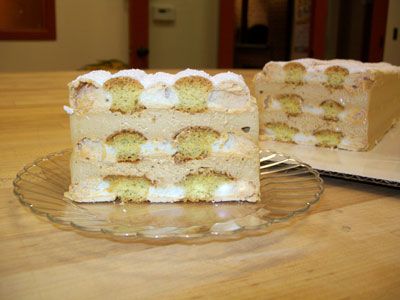
So far that presentation has eluded me. The Baking with Julia recipe, which I’ve pretty much decided to abandon, calls for a meringue-ladyfinger combo that’s baked at low heat. Both batters are extremely light — especially the ladyfinger batter which is virtually pure egg foam. Here they are on my first attempt:
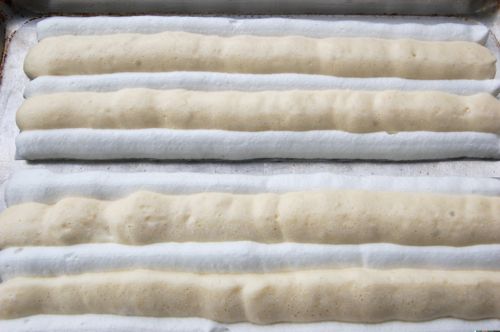
Here’s how they baked up. Not bad, but flat. This has a lot to do with the 300-degree oven temperature, which is quite low for ladyfinger batter which needs a heat blast to puff well.
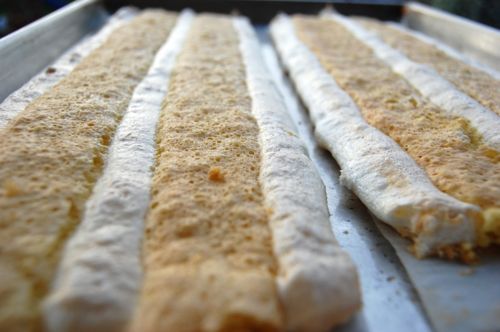
Convinced I’d made a mixing mistake, I kept after the recipe. However that second batter really vexed me. It needs to be whipped, but not over-whipped, since both lead to disaster. Here’s an under-whipped version (not so bad, but you can still see how difficult it is to pipe such a foamy, liquid-ish batter in straight lines).
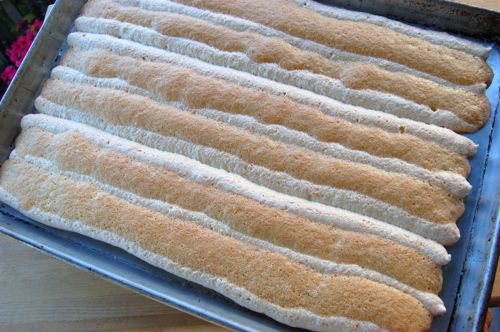
Over-whipped, things are worse. In this one the ladyfinger stripes were actually lower that the meringue stripes. No good-ski.
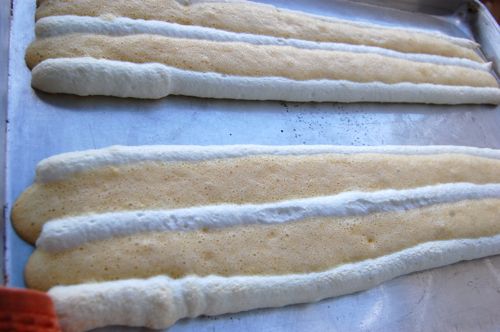
After five or so attempts I couldn’t figure out how to get a ladyfinger to puff at 300 degrees. So I switched over to the Nick Malgieri ladyfinger batter recipe, which calls for higher heat: 375 degrees Fahrenheit. The batter felt a lot better. It was a bit thicker and piped nicely. My first try seemed auspicious…
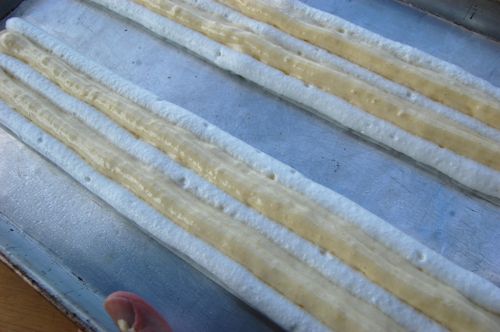
…but the higher heat caused the meringue to over-cook. Dang.
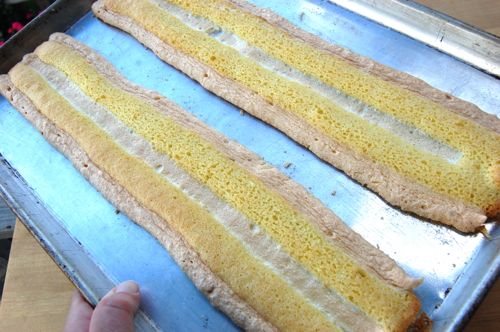
Next I’m planning a full-on Malgieri. The ladyfinger batter seems to work well (save for the big holes on top, which I hope to remedy). Logic dictates that the meringue — which I assume is formulated for higher heat tolerance — should work well too. But we’ll see.
Once I get the layers solved I’ll turn my attention to the slicing, an issue no one seems to want to talk about. Cardinal slice filling, as you may know from reading the recipe, is flavored whipped cream. How do you cut a three-layer pastry, filled with ultra-light whipped cream, into perfectly clean slices? A stabilizer and a freezer are no doubt the answer. Stay tuned!
Random idea since I really don’t know much about baking, which is why I read your blog– why don’t you pipe out stripes of ladyfinger with space between them, blast it with high heat for a few minutes, then pipe down the meringue in the spaces and finish the baking at a lower temp?
An outstanding idea but for the fact that ladyfinger batter is so runny that it needs something right next to it to support it as it bakes. That’s why ladyfingers are always piped right next to each other. But that’s first-class strategic thinking, Mary Sue!
Thank you,
– Joe
At moments like these I wish I had a blast freezer that would freeze the little sucker within an inch of its life and then it can be quickly sawed into blocks.
Thinking about this… one of the differences you’ve pointed out between US flours and other nations flours is in gluten quantity and type. Also, batters that sit for a while dome more when baked because the gluten has a chance to develop, but in a different way than using bread flour would (in my limited experience).
So… might changing the gluten quantity/type help the ladyfinger batter dome better? Substitute some bread flour, add some straight gluten, or even use a bread flour/cake flour mix (I’ve used it for chocolate chip cookies w/ Jacques Torres’ recipes, and it creates a nice combination of structure and tenderness)? Letting an egg foam sit for too long would cause problems, but is there a way to mimic the effect of letting the flour sit and become glutinous?
Obviously there’s a lot of possible ways to vary the gluten, and I don’t know how to guess the best ways.
Here’s hoping that Malgieri recipe works!
Very interesting idea, Mari. Very interesting indeed…
If you run out of ideas try using this recipe for the sponge
http://www.millyskitchen.co.nz/millysKitchen/index.cfm?35666F61-E018-8BD1-32BB-28FD2FA1844C&obj_uuid=A49098DD-E018-8BD1-3226-4184FAC74F43&stCurrentCat=005B6CDF-E018-8BD1-32A4-B1F118B9F1EB
It is not very runny.
Thanks Bronwyn!
– Joe
SEVEN times? Props for your dedication and high standards 🙂 That is patience that I can only admire. I definitely appreciate it, and can’t wait for the finished product!
Me neither! 😉
Re the filling: Renowned, classically trained pastry chef Ernest Weil used a new world technique for stabilizing whipped cream fillings-the addition of modest amounts of instant pudding powder. When I came across this technique in his “Love To Bake” cookbook, I was sort of flabbergasted by this unclassic solution. But it works, really well. Ernest used a lot of innovative techniques like this that in no way comprised the quality of his pastries. The wife and I have now baked several of his cakes that have whipped cream fillings made this way, and I swear by it now. You get a stiff but workable filling that won’t squirt out the sides when cut and holds up for days when refrigerated. For the basic filling: 3/4 c conf. sugar, 3 c heavy whipping cream, 1/4 c instant vanilla pudding powder, 2 tsp vanilla extract. Method: Mix confectioners’ sugar and instant vanilla
pudding powder and sift. Set aside. Pour the cream and vanilla extract into the bowl of the electric mixer. With the wire whisk attachment, on medium speed #4, whip until the cream starts to thicken. Add the confectioners’ sugar and vanilla pudding powder into the cream. Whip on medium high speed until the cream reaches a firm peak. Refrigerate until ready to use. He has versions for coffee and mocha fillings too. This recipe should make enough to fill and frost a 9 inch cake. The coffee and mocha versions make about two cups more I believe.
Fascinating. It makes sense: what is instant pudding but a thickener plus sugar and flavoring? I may well try that!
Cheers,
– Joe
hi joe, an idea from the apprentice, don’t laugh at my ignorance if this is junk, how about placing the cardboard rolls (left over in aluminium foil and plastic wrap cases) in between the batter..? may be we can make them stay still with some batter at the bottom and then pipe out the cake in between …? (your eyes are rolling right…!)
Hey, HB! At this point I’ll consider all suggestions! Thanks for the good thinking!
– Joe
I admire your dedication to the project!
In my experience (admittedly quite limited, but still), Nick Malgieri never disappoints.
Cop-out solution: bake the meringes and the ladyfingers separately, and then put them together in alternating rows. Use some of the cream frosting as “glue.” Freeze a bit so it all holds together. (And slice carefully, so it still all holds together.) Just don’t tell anyone that that’s how you did it. (Not even us.)
Heh…sounds good!
Maybe you should try the Julia Child recipe (actually Markus Farbinger’s recipe), from the Baking with Julia book. After piping both batters, they are baked with the door propped open a bit with the handle of a wooden spoon, until the meringue is dry and the sponge cake has puffed.
There’s a video here. Hope the link works. I have always wanted to make it, but now I’ll wait until I see that it works with you! I love your blog.
http://www.wonderhowto.com/how-to-make-viennese-cardinal-slice-5028/view/
Thanks Doris, that’s the recipe I’ve been trying over and over. It’s not working well for me for some reason. That sponge batter is just too liquid-y…and I really do think the heat is too low. But thanks!
– Joe
I guess you did try it. But did you do that propped open door? They also (in the video) pipe the meringue rows very close to each other and leave only a skinny place for the other batter, so that it doesn’t spread that much.
Indeed I think I tried it all…I piped, I propped…I did all sorts of things to no avail. Can’t figure that out…Julia Child books are almost always idiot-proof. Guess they didn’t figure on THIS idiot.
Oh well…
– Joe
perhaps chill the meringue mixture before piping it on, that way when you blast the ladyfingers the meringue will be a little bit protected?
That’s an interesting idea, Rachel. I may try that sometime, actually. Thank you!
– Joe
Hey Joe, Ran across your old blog about Cardinal cake as I was watching Cooking with Julia wherein Chef Farbinger was demonstrating same. Did you catch that he baked the meringue/ladyfinger strips with the oven door open? Something to do about letting the steam escape so the cooking was more even.
Hi Joe,
Thank you for using my picture of the Cardinal Slice as the “good example” at the top of this posting. It was a picture I took to use on our website to promote “‘Timeless Tortes” class at Zingerman’s BAKE! school. http://www.bakewithzing.com
I’ve been baking for 27 years professionally and help start the BAKE! school in 2006. I’d be more than happy to share tips on how to achieve the best results when making this pastry. I’ll even share with you the secret to slicing the Cardinal Slice. Making it a breeze to slice once you know how.
Please let me know if you are interested.
Happy Baking,
Alejandro Ramon
http://aramon65.wordpress.com
Very nice to meet you, Alejandro!
Your cardinal slices are a WHOLE lot better than mine, so of course I’d love to have your tips! This is one of those recipes I’d like to do over again because I was never very satisfied with the results. So…anytime!
Sorry for the late reply, I was on vacation!
Cheers,
– Joe